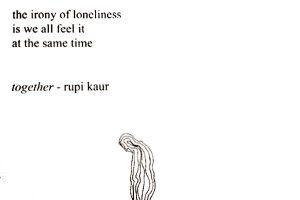But it’s not Poetry
November 1, 2019
Let it be known that while Rupi Kaur’s poetry revolves around traumatic events, including rape and sexual harassment, as well as self-appreciation, she often oversimplifies these subjects as well as the process of overcoming them. She often turns a blind eye to the people most vulnerable to these subjects by nearly formulating a recipe to move past these tragedies. And while she writes in a way so simple that her message can be easily understood by anyone, she makes herself almost too available by allowing everyone who reads her work to relate to events that they, thankfully, did not experience themselves.
Sure, people ought to understand the issues surrounding women’s rights and self-love; however, her writing frequently just defines these issues for what they are, rather than providing any sort of insight.
This is not poetry.
For a poet, Rupi Kaur has achieved a rare feat: mainstream popularity. Using social media as a major part of her fanbase, Kaur has become the frontrunner of a new generation of “instapoets”– young, aspiring poets publishing their work on social media to build their portfolio. Writing about topics that every teenager is convinced they have figured out–myself included– Kaur touches upon common themes: love, relationships, beauty standards, and gender inequity. In an attempt to perhaps distract easily swayed teenagers from having a genuine discussion about the aforementioned themes, Kaur gives her readers the false illusion of depth while merely capitalizing on lazy techniques.
Kaur sits on the fence between accessibility and over-simplicity and often stumbles into the latter. More often than not, her poetry presents obvious and mildly interesting shower thoughts in a visually appealing manner. For someone who is just starting to read poetry, Kaur can, and maybe even should, be applauded for her ability to pull young readers into her work, as she does not shy away from difficult topics. Her poetry is simple, to the point, and does not require multiple reads for comprehension.
Still, poetry is the presentation of a thought or an idea in a way that appeals to the public. Poetry does not have to be simple or complex to fall under the category of “good poetry.” It’s just not that binary. It should contain elements of intensity and should be rich in meaning, which can then contribute to the larger implications of the text. This is where Kaur fails miserably.
Her trademark of frequent, and often unnecessary, line breaks makes her most susceptible to criticism. Her work is moderately interesting at best as her tactic is to write about vague, taboo subjects that are difficult to disapprove the expression of. She then proceeds to take this sense of thematic intensity within her sentences, divides it into pieces, strips it of its punctuation, and accompanies it with an original chicken-scratch illustration that is vaguely reminiscent of the doodles found in the margins of children’s notebooks.
When asked to explain the lack of punctuation and capitalization in a CBS interview, Kaur claimed, “I want to basically get rid of as many distractions as I can, so that the reader can just pour themselves into the words.” However, in doing so, Kaur also distracts her readers from the issues at hand and gives them ample amounts of room on the pages of her poems to draw loosely related conclusions that can be posted on their Instagram stories later on.
Although other poets have followed a similar structure and line-break pattern, their poetry consists of a chaotic energy: a powerful subtext that calls out to readers to be discovered and interpreted. Kaur’s work simply lacks the interest and interaction that these poets challenge themselves to construct. I know the criticism of Rupi Kaur, especially coming from a high schooler, is a wildly unpopular opinion. However, to say that her writing adds to the literary canon is a gross exaggeration.













